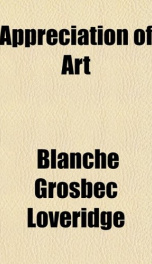appreciation of art

Purchase of this book includes free trial access to www.million-books.com where you can read more than a million books for free. This is an OCR edition with typos. Excerpt from book: Chapter III Painting. " For don't youmark ? we're made so that we love First when we see them painted, things we have passed Perhaps a hundred times nor cared to see; And so theyare better, paintedbetter to us, Which is the same thing. Art was given for that; God uses us to help each other so, [Lending our minds out." iRobert Browning. Fra Lippo Lippi. Painting is not as universal as architecture. At least it is not so closely associated with every man's need. Nor is it practiced so generally by all classes of people. Nevertheless it has great age to recommend it, for we find traces of color decoration in the relics of the cave dwellers among primitive men. Also as in architecture Egypt is the repository of the earliest examples of painting, so we begin a discussion of the subject with the statement that in 4000 A. D. paintings were madeonwalls.onmummy cases, and on papyrus rolls. They used six brightcolors, namely, green, blue, red, yellow, white, and black, and did little if any mixing and blending. In fact, they had a color language, different colors and degrees of colors representing different objects. Birds were green, water was blue, men and women were red, (men were the redder) and prisoners were yellow. Drawing meant very little to the Egyptian painter and he had no knowledge of perspective. Any decorative motive which his work might have had was entirely lost in the utilitarian side of the art. In short, Egyptian painting is both meager and prim' itive up to the third century, B. C., when Greek influence made itself felt in the Nile country. In Greece as in. Egypt, the earliest paintings are very crude. Up to the sixth century B. C. the color sense was apparent in a few tinted statues and reliefs of wood and clay. However in the next two hundred ye...
Info about the book
Author:
Series:
Unknown
ISBN:
1428075135
Rating:
5/5 (1)Your rating:
0/5
Languge:
English
Users who have this book
Users who want this book
What readers are saying
What do you think? Write your own comment on this book!
write a commentGenre
if you like appreciation of art try:
Other books by this author
Do you want to read a book that interests you? It’s EASY!
Create an account and send a request for reading to other users on the Webpage of the book!

